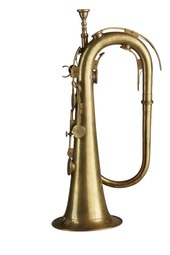Bugle
This article needs additional citations for verification. (April 2019) |
 Bugle in C | |
| Brass instrument | |
|---|---|
| Classification | |
| Hornbostel–Sachs classification | 423.1 (Simple aerophone sounded by lip vibration) |
| Developed | Antiquity; modern forms, c. 17th century |
| Related instruments | |
| More articles or information | |
The bugle is one of the simplest brass instruments, normally having no valves or other pitch-altering devices. All pitch control is done by varying the player's embouchure.
History[edit]

The bugle developed from early musical or communication instruments made of animal horns,[1] with the word "bugle" itself coming from "buculus", Latin for bullock (castrated bull).[2] The earliest bugles were shaped in a coil – typically a double coil, but also a single or triple coil – similar to the modern horn, and were used to communicate during hunts and as announcing instruments for coaches (somewhat akin to today's automobile horn). Predecessors and relatives of the bugle included the post horn, the Pless horn (sometimes called the "Prince Pless horn"), the bugle horn, and the shofar, among others. The ancient Roman army used the buccina.
The first verifiable formal use of a brass bugle as a military signal device was the Halbmondbläser, or half-moon bugle, used in Hanover in 1758. It was crescent-shaped (hence its name) and comfortably carried by a shoulder strap attached at the mouthpiece and bell. It first spread to England in 1764 where it was gradually accepted widely in foot regiments. 18th-century cavalry did not normally use a standard bugle, but rather an early trumpet that might be mistaken for a bugle today, as it lacked keys or valves, but had a more gradual taper and a smaller bell, producing a sound more easily audible at close range but with less carrying power over distance.
Uses[edit]
Pitch control is done by varying the player's embouchure. Consequently, the bugle is limited to notes within the harmonic series. Scores for standard bugle calls use the five notes of the "bugle scale".

The bugle is used mainly in the military, where the bugle call is used to indicate the daily routines of camp. Historically the bugle was used in the cavalry to relay instructions from officers to soldiers during battle. They were used to assemble the leaders and to give marching orders to the camps.
The bugle is also used in Boy Scout troops and in the Boys' Brigade.
The Rifles, an infantry regiment in the British Army, has retained the bugle for ceremonial and symbolic purposes, as did other rifle regiments before it. The buglers in each battalion are headed by the bugle major, a senior non-commissioned officer holding the rank of sergeant or above.
The bugle has also been used as a sign of peace in the case of a surrender.[citation needed]
In most military units, the bugle can be fitted with a small banner or tabard (occasionally gold fringed) with the arms of its reporting service branch or unit.[citation needed]
In military tradition, the Last Post or Taps is the bugle call that signifies the end of the day's activities. It is also sounded at military funerals to indicate that the soldier has gone to his final rest and at commemorative services such as Anzac Day and Remembrance Day In Australia and New Zealand.[3]
Chinese Eighth Route Army bugler during World War II. Photograph by Sha Fei.
American poster during the Second World War depicting a bugler from the Ethiopian National Defence Force Band
Variations[edit]

The cornet is sometimes erroneously considered a valved bugle, but the cornet was derived from more narrow-bored instruments, the French cornet de poste (lit. 'post horn') and cor de chasse (lit. 'hunting horn').
Keyed bugles (German: Klappenhorn) were invented in the early 19th century. In England, a patent for one design was taken out by Joseph Halliday in 1811 and became known as the Kent bugle. This bugle established itself in military band music in Britain and America, and its popularity is indicated by the existence of many published method books and arrangements.[4]: 139 It was in wide use until about 1850 by which time it had been largely replaced by the cornet. Richard Willis, appointed the first bandmaster of the United States Military Academy's West Point Band in 1817, wrote and performed many works for the keyed bugle.[4]: 137
Since the mid 19th century, bugles have been made with piston valves.
Pitches of bugles[edit]
- Soprano bugle (high pitch)
- Alto bugle (medium pitch)
- Baritone bugle (tenor pitch)
- Contrabass bugle (bass pitch)
References[edit]
Notes[edit]
- ^ "History of the Bugle Horn". www.army.mod.uk. Archived from the original on 5 October 2007. Retrieved 3 May 2008.
- ^ "bugle – Definitions from Dictionary.com". dictionary.reference.com. Retrieved 3 May 2008.
- ^ "The Last Post | Army.gov.au". www.army.gov.au. Retrieved 18 October 2021.
- ^ a b Dudgeon, Ralph T. (1997). "Keyed brass". In Herbert, Trevor; Wallace, John (eds.). The Cambridge Companion to Brass Instruments. Cambridge Companions. Cambridge University Press. p. 131–42. doi:10.1017/CCOL9780521563437. ISBN 978-1-139-00203-5. OCLC 460517551. Wikidata Q112852613.
Bibliography[edit]
- Ralph T. Dudgeon, The Keyed Bugle, Scarecrow Press, 2004, ISBN 0-8108-5123-7
- Janet Chiefari, Introducing the Drum and Bugle Corps, Olympic Marketing Corp, 1982, ISBN 0-396-08088-X




No comments:
Post a Comment